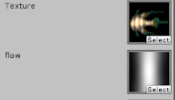well i can’t figure out what exactly you might be doing.
- I use remap to set the 0-1 range of black and white into a small output such as [-0.1] to [+0.1]
- it means 50% gray now = 0 and we have negative and positive motion.
- The other thing it does it sets the top and bottom values to only 1/10 what they use to be; that makes the distortion subtle, which it needs to be or you get wild distortion.
this remapped adjustment is added to UV, that means it will be combined into a UV layout rather than multiplying the UVs.
a value of +1 = +100% repositioning… it has left the image and come back on the other side. So that should tell you just a small .01 means the pixel has moved 1% of the image space and 5-10% is usually plenty of ‘wobble’
How do you go about picking a Noise texture for a certain VFX you want to make?
usually distortion is for randomness of a texture so that people can’t see it repeating; there was a time I needed a fish to swim and so I made a simple sine wave texture myself so that it was non-linear
It was this
that line just panned across X over infinity
a falloff *X so that the fish head was 0% distortion and the tail was 100%
black was -y
white +y
In order to know specific distortion you have to convert your minds artistic motion into the discrete numerics; That comes down to patience, practice and experience.
Unity URP (Universal Render Pipeline) has Simple (Perlin), Gradient and Voronoi
-
Most needs of noise is for randomness, so they can satisfy that… especially because you can always multiply two to get interference and process them with more calculation complexity.
-
a great deal of artistic RnD can be trial and error -
[edits, my bad gramer/spelling]

